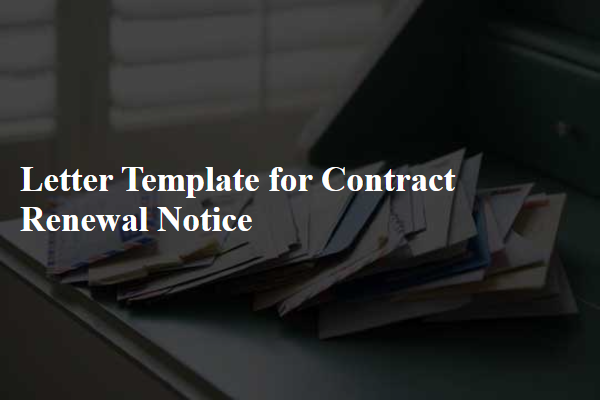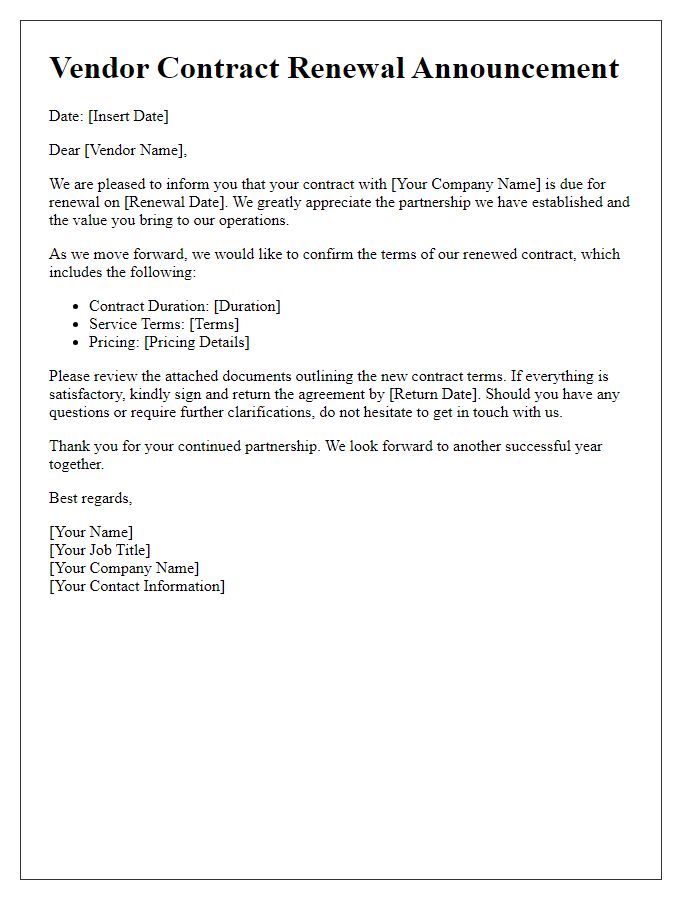Are you gearing up to renew a contract but unsure how to communicate it effectively? Crafting the perfect renewal notice can set the tone for continued collaboration and understanding. In this article, we'll dive into the essential elements of a well-structured contract renewal letter, ensuring clarity and professionalism. So, let's explore the best practices that will keep your agreements running smoothly!

Clear subject line
Subject: Contract Renewal Notice for [Contract Name/Type] This is a formal notice regarding the renewal of the [Contract Name/Type] scheduled for [Renewal Date]. The terms of the current agreement, initiated on [Start Date], have proven beneficial for both parties involved in this arrangement. The renewal process includes reviewing the contract terms and conditions to ensure alignment with current operational needs and market standards. It is essential to finalize discussions by [Negotiation Deadline] to maintain uninterrupted services. Please prepare any necessary documentation and reach out for a meeting to discuss the renewal details.
Contract details summary
A contract renewal notice serves as a formal communication to inform all involved parties about the impending expiration of a current agreement and the option to renew it. An effective contract can include specific details such as the contract start date (January 1, 2022), end date (December 31, 2023), renewal terms (automatic renewal for one year), and parties involved (XYZ Corporation and ABC Services, Inc.). Relevant conditions such as performance metrics, payment terms ($5,000 monthly), and expiration notice period (30 days prior) should also be outlined, ensuring clarity. This structured summary aids in maintaining a mutual understanding and prepares all stakeholders for the continuation or modification of the existing obligations.
Renewal terms and conditions
Contract renewal notices encode important information about continuation terms. Key elements include effective date (often a specific day, month, and year), renewal duration (often expressed in terms of months or years), and any changed conditions (such as pricing adjustments or service levels). Specific parties involved (companies or individuals distinct by their business identifiers), must be clearly stated. Reference to jurisdiction governs legal implications (noting state or country laws). Renewal clauses spell out opt-out provisions and notification timelines (usually ranging from 30 to 90 days). Finally, signatures from both parties affirm the agreement (especially required for corporate entities).
Contact information for queries
A contract renewal notice is essential for maintaining agreements between parties involved in business, whether it's suppliers, clients, or employees. Clear and concise contact information is vital for resolving any queries related to the renewal process. Including phone numbers (direct lines, possibly including area codes), email addresses (professional domains), and office locations (specific addresses, including city and state) can foster open communication. Additionally, specifying the name of a primary contact person (with a title such as Contract Manager) will ensure that inquiries are routed appropriately, minimizing delays and confusion during the renewal discussions. Providing this detailed contact framework encourages timely responses and facilitates a smoother renewal experience for both parties.
Deadline for response
A contract renewal notice serves as an official reminder for parties involved to evaluate their existing agreement and to respond before the specified deadline. This notice typically highlights key elements of the contract, such as the expiration date, any significant changes in terms or conditions, and the importance of timely feedback. For instance, if the original contract was established on January 1, 2022, and is set to expire on December 31, 2023, the notice might specify a response deadline of November 30, 2023. This allows sufficient time for discussion and negotiation. Clarity in communication is paramount to ensure that all parties are aligned on expectations and obligations moving forward. Ensuring that responses are received by the designated date is crucial for maintaining the continuity of the contractual relationship.













Comments